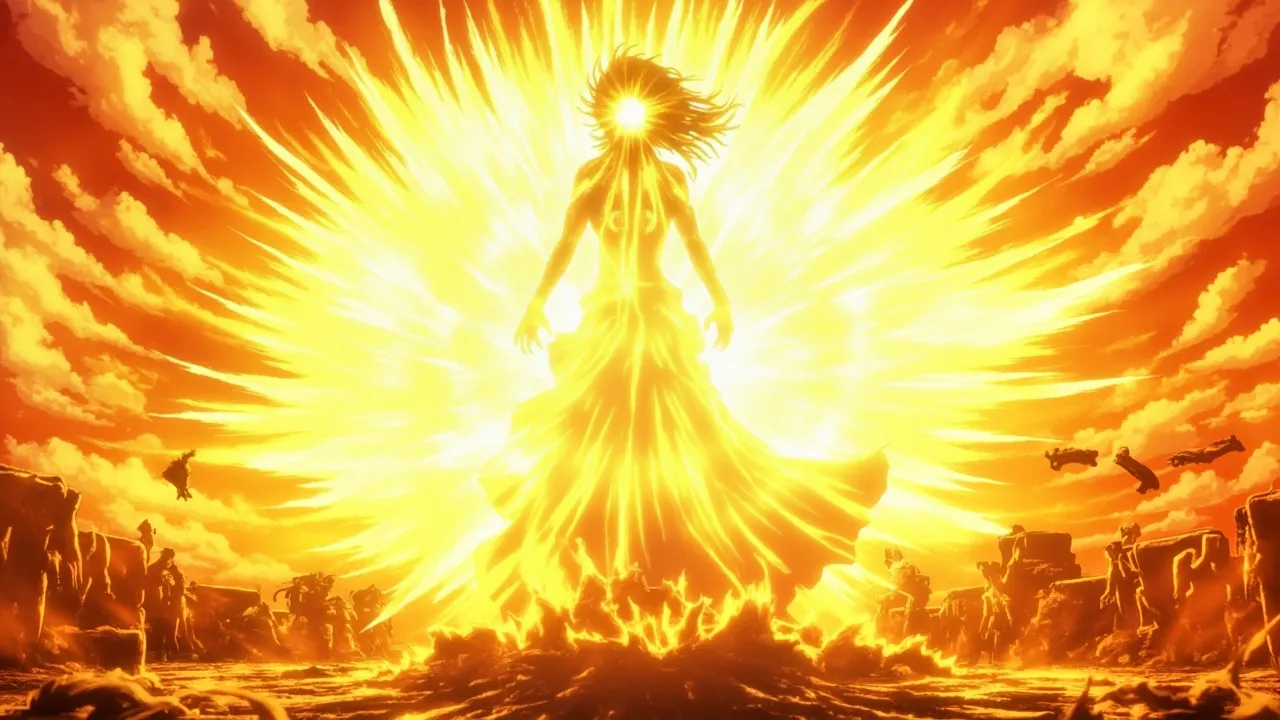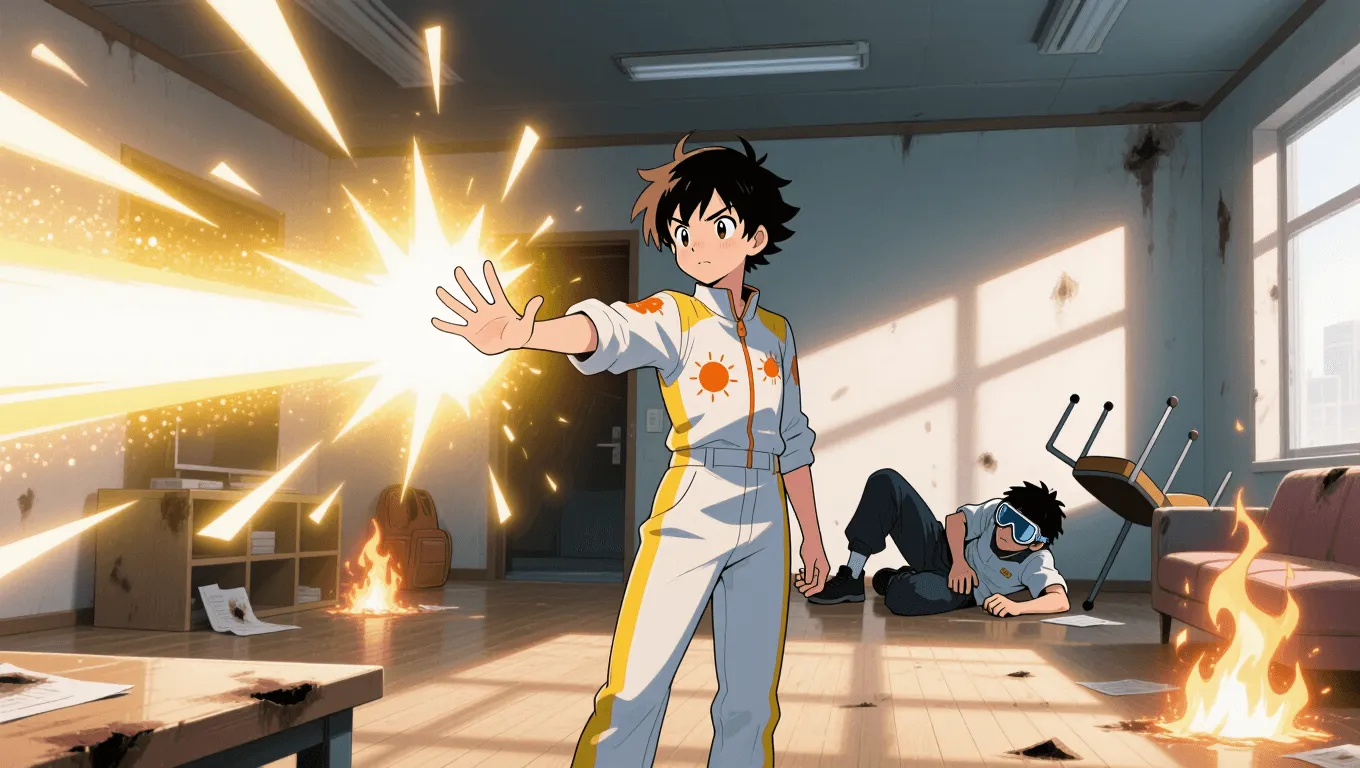Solar Flare

Solar Flare Video Demo 🎬
Table of Contents
Solar Flare is a high-intensity energy ability that unleashes concentrated bursts of solar light and heat to blind, scorch, or overwhelm foes. In many power systems it sits between photokinesis and pyrokinesis, drawing on solar radiation to produce blinding flashes, radiant heat, and even brief plasma eruptions. This guide explains how the superpower works, how it scales, and how to counter it. For more powers, explore the Superpower Wiki and try the Random Superpower Generator.
What Is Solar Flare
Solar Flare is the capacity to generate and manipulate solar-spectrum energy—visible light, ultraviolet, and infrared—with momentary spikes that mimic miniature coronal events. Practitioners can produce flashbang-level brilliance, focused heat beams, radiant shields, and short-lived plasma jets. Unlike pure light manipulation, Solar Flare couples luminosity with destructive thermal output; unlike standard fire control, it does not rely on combustion and can function in low-oxygen environments. Advanced users learn to absorb sunlight like a battery, then re-emit it as controlled photonic and thermal payloads.
Core Abilities of Solar Flare
Radiant Flash Emission
Users create an intense photonic burst that floods an area with daylight-level or greater luminosity. This “flare” overwhelms retinas and optical sensors, causing temporary blindness, afterimages, and targeting disruption. Tuned correctly, the flash can exclude certain wavelengths to reduce risk to allies while still stunning enemies.
Thermal/Plasma Projection
Beyond light, advanced users compress energy into heat lances and flare bolts—brief, white-hot streams that can soften metal, slag armor, or cauterize breaches. At peak output the air ionizes into a short-lived plasma filament, delivering cutting or blasting effects with limited splash compared to wide-area flames.
Spectrum Control (UV–Visible–IR)
A hallmark of Solar Flare is spectrum steering. Infrared output bakes targets or creates heat mirages; visible output illuminates or dazzles; ultraviolet can sterilize, scorch, or degrade certain materials. Selective wavelength control allows tactical effects like UV tagging (making foes glow under specific optics) or IR smokescreen burn-through.
Solar Shielding (Radiant Barrier)
By projecting outward-facing luminosity and thermal gradients, users form a “flare mantle” that ablates projectiles, dazzles incoming guidance systems, and deters melee approach. While not a true force field, the radiant barrier can reduce kinetic penetration and melt or soften incoming microthreats (e.g., drones, nets).
Energy Absorption and Recharge
Under direct sunlight, the wielder passively recharges. Cloud cover reduces throughput but does not nullify it; stored charge fuels flashes at night. Some users can sip ambient light to avoid total depletion, though peak outputs still need banked energy.
Environmental Control & Illumination
Solar Flare doubles as a mobile sunlamp. It can banish darkness, counter shadow-based abilities, and project daylight conditions underground. Controlled bursts can desiccate damp ground, thaw ice locks, and sterilize contaminated surfaces via targeted UV.
Precision Photonics
With practice, the user sculpts beam diameter and pulse duration—tight “needle” cuts for surgical tasks, broad cones for crowd control. Micro-pulsing enables nonlethal effects like photonic strobe patterns tuned to scramble targeting optics without causing lasting harm.
Application / Tactical Advantages in Combat
Crowd Control: A split-second flash disorients groups, breaks ambushes, and buys breathing room. In urban warfare, ricocheting light denies cover by flooding alleys and rooms with glare.
Area Denial: Sustained IR output superheats surfaces, discouraging advance through chokepoints. Heat shimmer distorts sightlines, degrading long-range accuracy.
Armor Defeat: Focused plasma lances weaken plate seams, weld shut visor slits, or burn through cables. Against drones, glare blinds cameras while heat warps rotors.
Counter-Stealth: Solar Flare erases deep shadows, reveals heat signatures against newly warmed backgrounds, and disrupts invisibility fields that rely on low-light conditions.
Nonlethal Options: Controlled bursts act like a clean photonic taser for vision and balance—no shrapnel, minimal collateral fire risk compared to explosives.
Signal & Morale: A directed flare doubles as a signal beacon for allies and a psychological shock for enemies—sunrise at midnight rattles pursuit teams and predators alike.
Level: Level 1 🏙️, Level 2 🌇, Level 3 🌃
Level 1 — Spark of Dawn
Beginners manifest bright flashes and localized heat spots roughly equal to industrial floodlights plus a hotplate. Effective range is room-scale. They can blind foes wearing standard goggles, ignite tinder-dry materials, and raise surface temperatures enough to welt or blister unprotected skin. Recharge requires steady sun exposure or long rests. Precision is limited; friendly-fire flash is a real risk.

Milestones:
-
Safe-flash training to minimize ally exposure
-
First coherent beam (flashlight-to-laser progression)
-
Basic UV tuning for decontamination or tracking inks
Typical Counters at L1: Standard visor filters, mirrored shields, smoke screens to diffuse beams.
Level 2 — Noon Zenith
Intermediate users generate battlefield-grade brilliance and sustained heat projection. They can shape beams from pencil-thin to doorway-wide and hold a flare mantle long enough to melt thrown weapons or jam seekers. Short plasma spikes cut rebar, weld breaches, or crater masonry. Stored charge supports several engagements without sunlight.

Milestones:
-
Multi-spectral bursts (strobe patterns that scramble optics/sensors)
-
IR mirage fields for lane denial
-
Plasma filament control for “white line” cutting
Typical Counters at L2: Purpose-built anti-flash visors, ablative coatings, energy-damping fields, cryokinetic barriers that wick heat.
Level 3 — Coronagraph Apex
Masters treat light and heat like sculpting clay. They produce compact coronal jets with minimal collateral, emit UV-precise sterilization beams, and project near-continuous radiant shields. At this stage, Solar Flare doubles as a logistics tool—rapid thawing, emergency welding, sterilizing field hospitals—and a decisive combat option. Even at night, banked reserves and ambient siphoning keep them dangerous.

Milestones:
-
Adaptive flare mantle that auto-dims for allies while overexposing hostile sensors
-
Beam splitting to engage multiple targets simultaneously
-
Sun-assisted overcharge states with brief, devastating plasma arcs
Typical Counters at L3: High-grade photonic dampeners, electromagnetic redirection of plasma paths, composite mirrors with active cooling, hardlight shields.
Limitations of Using the Solar Flare
Energy Budget: Peak flares drain reserves rapidly. Without sun or a recharge window, output collapses from plasma-grade to flashlight-grade. Overdrawing causes photonic burnout—temporary inability to emit without pain or nausea.
Collateral Brightness: Unshielded, the flash risks ally blindness, civilian harm, and sensor damage. Careless use indoors can ignite volatile materials or ruin evidence with thermal shock.
Thermal Management: The user’s body must dump heat. Overuse leads to overheating, dehydration, and heatstroke-like symptoms. Specialized suits often include heat exchangers and reflective underlayers.
Line-of-Sight & Medium: Dense smoke, particulate clouds, and refractive fields scatter beams. Water and conductive fog sap heat faster, clipping effective range.
Weather Dependence: Cloud cover and high-latitude winters slow recharge. While stored energy helps, prolonged darkness puts the user on a timer.
Reflective Hazards: Polished mirrors, ice walls, or reflective metasurfaces can bounce beams back, creating friendly-fire risks or null zones.
Ethical/Operational Limits: UV sterilization and high-IR outputs can harm bystanders or ecosystems; responsible users deploy attenuated settings outside active combat.
Weakness Against What Other Superpowers
Shadow/Umbrakinesis: Deep shadow fields absorb or occlude light, collapsing Solar Flare’s dazzle advantage and forcing the user to rely solely on heat output.
Cryokinesis & Thermal Absorption: Cold walls and heat-sink constructs sponge up IR, protecting targets and shortening plasma persistence times.
Electromagnetic Manipulation: Since plasma follows magnetic lines, EM controllers can bend, bottle, or backfire flare jets.
Photonic Dampening & Null Fields: Dedicated dampeners reduce luminance and clamp peak intensity, turning blinding flashes into bright-but-manageable glows.
Reflective/Refraction Shields: Mirror shields and prismatic domes redirect beams, potentially exposing allies. Advanced versions split or phase-shift incoming light.
Energy Vampirism/Absorption: Energy absorbers drink the output, converting Solar Flare into fuel for themselves or harmless heat elsewhere.
Particulate Control (Dust, Fog, Sand): Aerosolized barriers scatter wavelengths and bleed heat away, blinding the user’s own sightlines while protecting defenders.
Synergistic Power Combos
Force-Field Architecture: Partnering with a barrier caster allows safe containment of plasma arcs, focusing damage without collateral and protecting allies from glare.
Aerokinesis: Air shaping lengthens plasma reach, clears smoke, and enhances mirage distortion for area denial.
Photokinetic Constructs: Solid-light platforms and lenses turn Solar Flare into precision tools—beam splitters, focus arrays, or moving mirrors to curve shots around cover.
Gravity Manipulation: Micro-lensing via gravity wells tightens beam coherence, creating surgical, long-range strikes.
Electrokinesis: Electrical pre-ionization lowers the energy cost to sustain plasma filaments, improving efficiency and stability.
Speed/Teleportation: Hit-and-flash tactics—brief teleports or speed dashes combined with point-blank dazzles—break enemy formations without prolonged exposure.
Tectonic/Metal Control: Superheating stress lines before a geokinetic or ferromancer strike causes brittle failure in fortifications for combo breaches.
Known Users
-
Starfire (DC Comics) — Projects “starbolts” derived from absorbed solar radiation; her bright, heat-laden blasts exemplify the Solar Flare toolkit. Learn more about Starfire.
-
Sunfire (Marvel Comics) — A solar-powered mutant who channels intense radiation into fiery blasts and flight. Learn more about Sunfire.
-
Sunspot (Marvel Comics) — Absorbs and metabolizes solar energy to enhance strength and project radiation; advanced versions exhibit photonic discharge. Learn more about Sunspot.
-
Doctor Solar (Dark Horse/Gold Key) — A classic energy manipulator with solar-themed feats including radiation projection and matter-energy tricks. Learn more about Doctor Solar.
-
Tien Shinhan & Krillin (Dragon Ball) — Known for the “Solar Flare” technique: a blinding burst used for escapes or openings. Learn more about Tien Shinhan. / Learn more about Krillin.
Note: These characters demonstrate variations of solar energy manipulation, radiant bursts, and plasma-like projection that align with this superpower’s core mechanics.
